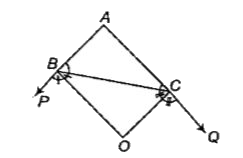If ΔABC,∠A=52∘, Its sides AB and AC are produced to the points D and E respectively. If the bisectors of the ∠CBDand∠BCE meet at point O, then ∠BOC is equal to:
106∘
64∘
16∘
32∘
The correct Answer is:B
To solve the problem, we need to find the angle ∠BOC given that ∠A=52∘ in triangle ABC and the sides AB and AC are extended to points D and E respectively.
1. Understanding the Angles:
- We know that ∠A=52∘.
- Let ∠B=∠1 and ∠C=∠2.
2. Using the Exterior Angle Theorem:
- The exterior angle ∠CBD (which is ∠1+∠2) is equal to the sum of the opposite interior angles:
∠CBD=∠A+∠2=52∘+∠2
- Similarly, for ∠BCE:
∠BCE=∠A+∠1=52∘+∠1
3. Setting Up the Angles at Point O:
- Let ∠BOC=x and ∠OBC=y.
- Since O is the intersection of the angle bisectors, we have:
∠OBC=12∠CBD=12(52∘+∠2)=52∘+∠22
∠BCO=12∠BCE=12(52∘+∠1)=52∘+∠12
4. Using the Triangle Sum Property:
- In triangle ABC, the sum of angles is 180∘:
∠A+∠B+∠C=180∘
52∘+∠1+∠2=180∘
∠1+∠2=128∘
5. Finding ∠BOC:
- Now we can express ∠BOC in terms of x and y:
∠OBC+∠BCO+∠BOC=180∘
52∘+∠22+52∘+∠12+x=180∘
- Substituting ∠1+∠2=128∘:
52∘+∠2+52∘+∠12+x=180∘
104∘+128∘2+x=180∘
232∘2+x=180∘
116∘+x=180∘
x=180∘−116∘=64∘
Thus, ∠BOC=64∘.
- We know that ∠A=52∘.
- Let ∠B=∠1 and ∠C=∠2.
- The exterior angle ∠CBD (which is ∠1+∠2) is equal to the sum of the opposite interior angles:
∠CBD=∠A+∠2=52∘+∠2
- Similarly, for ∠BCE:
∠BCE=∠A+∠1=52∘+∠1
- Let ∠BOC=x and ∠OBC=y.
- Since O is the intersection of the angle bisectors, we have:
∠OBC=12∠CBD=12(52∘+∠2)=52∘+∠22
∠BCO=12∠BCE=12(52∘+∠1)=52∘+∠12
- In triangle ABC, the sum of angles is 180∘:
∠A+∠B+∠C=180∘
52∘+∠1+∠2=180∘
∠1+∠2=128∘
- Now we can express ∠BOC in terms of x and y:
∠OBC+∠BCO+∠BOC=180∘
52∘+∠22+52∘+∠12+x=180∘
- Substituting ∠1+∠2=128∘:
52∘+∠2+52∘+∠12+x=180∘
104∘+128∘2+x=180∘
232∘2+x=180∘
116∘+x=180∘
x=180∘−116∘=64∘
Similar Questions
In △ABC ,∠A=72∘. Its sides AB and AC are produced to the point D and E. If the bisectors of the ∠CBD and ∠BCE meet at the point O, then ∠BOC will be equal to:
त्रिभुज ABC में, ∠A=72∘ है | इसकी भुजाओं AB और AC को बिंदु D तथा E तक बढ़ाया जाता है | यदि कोण CBD और कोण BCE के समद्विभाजक बिंदु O पर मिलते हैं, तो ∠BOC का मान ज्ञात करें |View SolutionIn a △ABC, ∠A=52∘. Its sides AB and AC are produced to the points D and E respectively. If the bisectors of the ∠CBD and ∠BCE meet at point O, then ∠BOC is equal to:
△ABC में ∠A=52∘ है। इनकी भुजाएं AB और AC क्रमशः D और E तक बढाई जाती है। अगर ∠CBD और ∠BCE समदूविभाजक बिंदु O पर मिलते हैं, तो ∠BOC बराबर हैःView Solution
Knowledge Check
- Question 1 - Select One
In △ABC ,∠A=50∘. Its sides AB and AC are produced to the point D and E. If the bisectors of the ∠CBD and ∠BCE meet at the point O, then ∠BOC will be equal to:
त्रिभुज ABC में, ∠A=50∘ है | इसकी भुजाओं AB और AC को बिंदु D तथा E तक बढ़ाया जाता है | यदि कोण CBD और कोण BCE के द्विभाजक बिंदु O पर मिलते हैं, तो ∠BOC का मान क्या होगा ?A70∘B65∘C55∘D40∘ - Question 2 - Select One
In figure, sides AB and AC of a ΔABC are produced to P and Q, respectively. The bisectors of ∠PBCand∠QCB intersect at O. Then, ∠BOC is equal to
 A90∘−12∠BACB12(∠PBC+∠QCB)C90∘+12∠BACDNone of the above
A90∘−12∠BACB12(∠PBC+∠QCB)C90∘+12∠BACDNone of the above - Question 3 - Select One
In △ABC ,∠B=68∘ and ∠C=32∘ . Sides AB and AC are produced to points D and E, respectively. The bisectors of ∠DBC and ∠BCE meet at F. What is the measure of ∠BFC ? /
△ABC में, ∠B=68∘ तथा ∠C=32∘ है | भुजाओं AB और AC को क्रमशः बिंदु D और E तक बढ़ाया जाता है | ∠DBC तथा ∠BCE के समद्विभाजक F पर मिलते हैं | कोण BFC का मान ज्ञात करें |A65∘B50∘C55∘D39∘
In △ABC ,∠A=72∘. Its sides AB and AC are produced to the point D and E. If the bisectors of the ∠CBD and ∠BCE meet at the point O, then ∠BOC will be equal to:
त्रिभुज ABC में, ∠A=72∘ है | इसकी भुजाओं AB और AC को बिंदु D तथा E तक बढ़ाया जाता है | यदि कोण CBD और कोण BCE के समद्विभाजक बिंदु O पर मिलते हैं, तो ∠BOC का मान ज्ञात करें |View SolutionIn △ABC ,∠A=50∘. Its sides AB and AC are produced to the point D and E. If the bisectors of the ∠CBD and ∠BCE meet at the point O, then ∠BOC will be equal to:
त्रिभुज ABC में, ∠A=50∘ है | इसकी भुजाओं AB और AC को बिंदु D तथा E तक बढ़ाया जाता है | यदि कोण CBD और कोण BCE के द्विभाजक बिंदु O पर मिलते हैं, तो ∠BOC का मान क्या होगा ?View SolutionIn △ABC ,∠A=50∘. Its sides AB and AC are produced to the point D and E. If the bisectors of the ∠CBD and ∠BCE meet at the point O, then ∠BOC will be equal to:
त्रिभुज ABC में, ∠A=50∘ है | इसकी भुजाओं AB और AC को बिंदु D तथा E तक बढ़ाया जाता है | यदि कोण CBD और कोण BCE के द्विभाजक बिंदु O पर मिलते हैं, तो ∠BOC का मान किसके बराबर होगा ?View SolutionIn △ABC ,∠A=66∘. AB and AC are produced to points D and E respectively. If the bisector of angle ∠CBD and ∠BCE meet at the point O, then ∠BOC is equal to :
त्रिभुज ABC में, ∠A=66∘ ,AB और AC क्रमशः D और E तक बढ़ाये जाते हैं। यदि कोण ∠CBD और ∠BCE के सम द्विभाजक बिंदु O पर मिलते हैं, तो ∠BOC के ज्ञात करेView SolutionIn ∠ABC, AB and AC are produced to points D and E respectively. If the bisector of ∠CBD and ∠BCE meet at a point O and ∠BOC=57∘, then ∠A is equal to :
त्रिभुज ABC में, AB और AC क्रमशः D और E तक बढ़ाये जाते हैं। यदि कोण ∠CBD और ∠BCE के सम द्विभाजक बिंदु O पर मिलते हैं, और ∠BOC=57∘ तो ∠A बराबर हैView Solution
